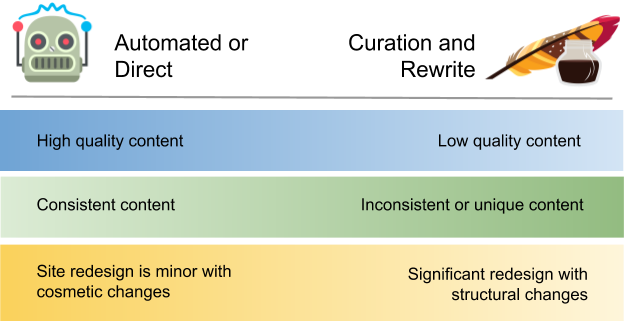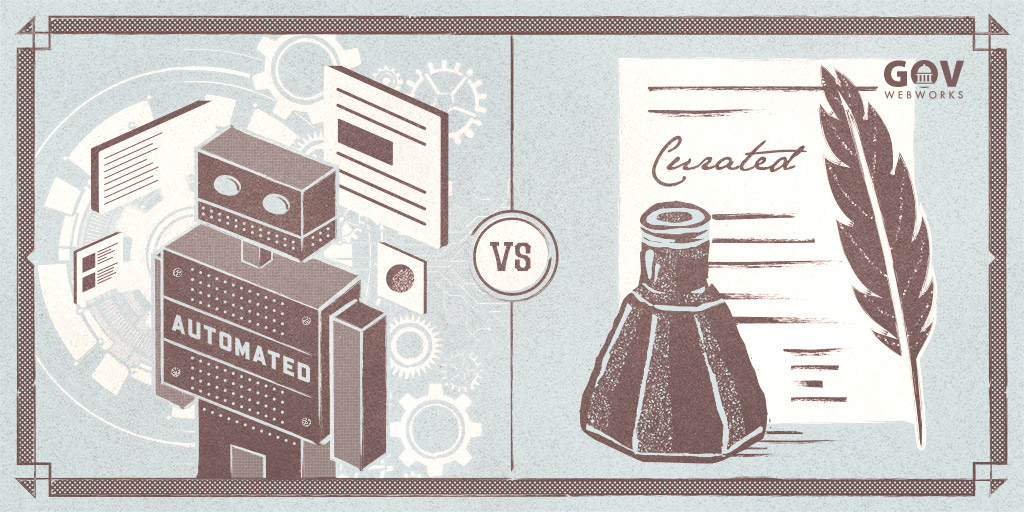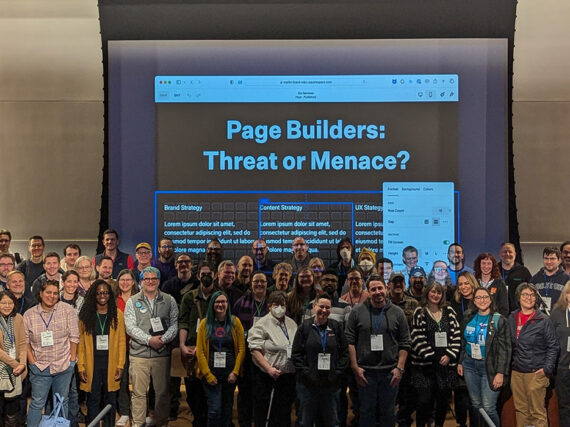Content migration might not be the absolute scariest part of a site redesign, but it’s a contender. Leaving migration out of our redesigns isn’t an option either; content is the reason we build websites in the first place. This means you’ll need to move content from an old to a new system whenever you’re:
- Redesigning a site
- Upgrading an existing site to new / different technology
- Consolidating sites
In any of these scenarios, you’ve got old content including pages, documents, and user accounts or data. This content often represents years, or even decades of work.
Starting from scratch is almost never an option, so how do we get that content into a new system?
Reviewing the options
There are two main strategies for migration: direct and curated.
Direct or automated migration is where we move content from point A to point B without changing it significantly. This method has a lot of potential to use automation which can save you time and money. Automation is possible using developer made tools (such as Drupal’s Migrate API) to map source data, process it, and move that data to a new destination.
Curated migration involves putting human eyes on every piece of content, and usually requires a lot of rewriting. Curation requires making choices about what stays behind, what rides along to the new system, and what needs to be updated or rewritten. Content rewrites are often done with some combination of internal employees and hired web copywriters.
So which option is best? Well, your existing content has a lot to say about that.
Choosing a strategy
Depending on where your content lands in the site redesign “spectrum,” you’ll need more automation or more curation.

If your content is a mix of automation and curation candidates, you’re not alone. Normally we recommend a mixed approach – a truce between automation and curation. To understand why, we’ll take a closer look at these two migration strategies and when to use them.
Automated migration: hard for humans, easy for scripts (sometimes)
Let’s be honest, most of us want an automated approach to migration. On the face of it, we ought to avoid a lot of heartache and cost by taking an automated approach. Under the right circumstances, direct or automated migration has a lot of benefits:
- Remove the need for decision making on each page
- Reduce human error in large data transfers
- Often drastic reduction in labor during the project
That sounds like it will be faster, better, and cheaper, doesn’t it? Looks can be deceiving and under the wrong circumstances there are a lot of pitfalls. The hidden costs of direct migration are where a lot of site redesigns run into trouble.
Sneaky cost #1: Square peg, round hole
If the new “bucket” for your content is not very similar to the old “bucket,” automation becomes difficult or even impossible. You’re then left with people copy and pasting manually and trying to make the old content fit into its new home: a recipe for frustration and high cost. Not only is this tricky to pull off, it often shows in the end result and leaves beautiful new designs poorly realized.
Sneaky cost #2: Poor quality content
The risks of poor quality content are numerous, and more likely than not, poor content is why your site feels outdated in the first place. Usability issues and poor user experiences are often because of bloated and disorganized content, not design or technology. A beautiful site will be unpleasant to use if the content isn’t well thought out.
So be honest with yourself: is your current content going to be an asset or a liability in the new site?
Sneaky cost #3: Migration is more expensive than you think
While direct migration can be much cheaper than re-writing content, it’s still pretty expensive. Automation can save loads of time when content is consistent and really vast. Yet even the best candidates for automated migration take development time to set up. Direct migration, automated or otherwise, requires significant human effort.
Automated migration “out of the box” is a lie. There are a lot of products out there that promise a quick and easy solution for any website. This just isn’t true for 99 percent of cases. Don’t buy migration snake-oil solutions!
Is automated migration a realistic approach to save money?
The answer here is: it depends on how much you want to automate. There are some terrific opportunities to automate migration on nearly every project. If you have loads of documents, user accounts, or content that you’re obligated to provide, automation might be a really good fit. Those archives of press releases and regulatory documents aren’t going to benefit from a rewrite.
Chances are that direct or automated migration won’t work well for all your content, or even most of it. Some of these “sneaky costs” are unavoidable. However, more often we invite those sneaky costs into our budgets by being dishonest with ourselves. We don’t like to face the reality of how challenging migration is going to be with our current content.
Don’t let denial sink your migration budgets!
Curated migration: long term gains over short term pains
Curating content by pruning, rewriting, and inspecting for quality as part of migration sounds like a lot of work – and it is. It’s a very, very, very large amount of work (see our previous post on simplifying content migration), and we tend to underestimate just how much labor is involved in our content. However, there are a lot of really good reasons to consider taking the plunge.
Surprising benefit #1: It’s the best chance to save budget and scope
Curating content involves pruning content. Eliminating content is the easiest way to save money and rein in project scope. We’ve seen it time and time again where content in the old site dictates costly templates for the new site. What if we didn’t need those pricey templates and tools at all?
Focusing on only the highest value content both saves you money in the implementation phase … as well as post-launch. If you have half the content, you have half the staffing needs. Pruning our content keeps sites sustainable, which also means we have to redesign them less often.
Surprising benefit #2: You’ll get a better, more usable, more beautiful site
When content is crisp and clean, with a unity in purpose across design and mission, the whole site feels more beautiful. Wordy, bloated content makes sites harder to use and less engaging. Your content shouldn’t be counterproductive to the designers – and developers – hard work.
Content that isn’t valued by your audiences (or worse, makes the site hard to use), is content that’s burning money. Even high quality content can be improved or better utilized. Direct migration robs you of the ideal opportunity to make these improvements.
Surprising benefit #3: You can test and adapt the site before launch
As Agile practitioners, iterative development based on user feedback is at the heart of what we do. The problem is that the majority of your CMS users – content authors – don’t use the site until after launch. Sure they might attend demos and agree that it looks nice, but dollars to donuts they’ll find things after go-live they wish were different. At that point, the money is spent, and any improvements have to wait for the next budget cycle.
Getting your authors in during active development is a terrific chance to see which templates and features they will like – and which they don’t. Given this real time feedback, developers and designers can make better tools and improvements before the budget runs dry.
Is a curated approach to migration realistic and affordable?
The answer here is: it depends on how much you want to curate. Chances are it’s not feasible to rewrite all your existing content, however it may be possible to rewrite or update most of your new content. How can that be done? By pruning your content, prioritizing what you really need for site launch, and automating what makes sense to direct migrate.
While automation and cutting outdated or low value content can help, it’s still going to be a lot of effort to curate content. If you won’t have time to dedicate to curation or budgets to hire copywriters, setting out on an ambitious content project is doomed to failure.
In summary ?
- Be honest with yourselves about the state of your current content – denial is expensive
- Don’t pay money to move poor quality content, it’s just not worth it
- Automation will save money when used wisely, but it’s not a silver bullet
- Content curation is almost always an expensive, but necessary, investment
Sometimes it might feel like battle lines get drawn between the curators and the automators. Yet successful projects are built on cooperation – and peace – between these two camps.
Learn more
- StoryTeller:
5 Hidden Risks of Creating Boring Content - GatherContent:
How to find break-through content solutions that work for both stakeholders and users
How a technology company used GatherContent to overcome content woes during a website redesign - Questions about content migration:
Contact us
Author bio
As Project Coordinator, Caroline Casals fills the roles of quality assurance tech, Drupal developer, content strategist, and content migration lead. She enjoys helping clients tell their stories and fall in love with their site all over again.







